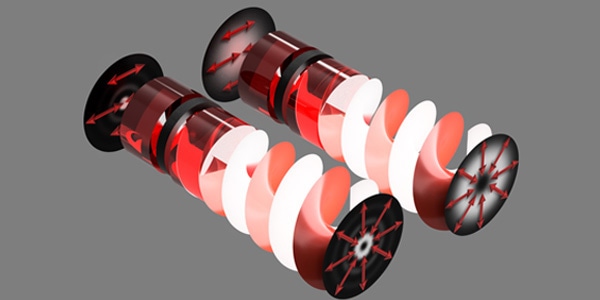Nov 6 2019
Structured light offers an extravagant way to elucidate pictures or patterns of light, but this is absolutely justified because it promises upcoming communications that would be faster, and at the same time, would be more secure.
 The creation of hybrid entangled photons by combining polarization with a “twisted” pattern that carries orbital angular momentum. Image credit: University of the Witwatersrand
The creation of hybrid entangled photons by combining polarization with a “twisted” pattern that carries orbital angular momentum. Image credit: University of the Witwatersrand
During the last century, quantum mechanics has evolved considerably but it still has a long way to go. Scientists at the University of Witwatersrand (Wits University) in South Africa assessed the development being made in the use of structured light in quantum protocols to produce a bigger encoding alphabet, better resistance to noise, and stronger security. The study has been reported in AIP Publishing’s AVS Quantum Science.
What we really want is to do quantum mechanics with patterns of light. By this, we mean that light comes in a variety of patterns that can be made unique— like our faces.
Andrew Forbes, Study Co-Author and Professor, School of Physics, University of the Witwatersrand
Patterns of light can be utilized as a form of alphabet because they can be differentiated from one another. “The cool thing is that there are, in principle at least, an infinite set of patterns, so an infinite alphabet is available,” added Forbes.
Conventionally, quantum protocols have been applied to the polarization of light. This light possesses just two values—that is, a two-level system with the highest data capacity for each photon of just 1 bit. However, when patterns of light are used as the alphabet, the data capacity becomes relatively higher. Its security is also more robust, and the resistance to noise (like fluctuations in the background light) is enhanced.
“Patterns of light are a route to what we term high-dimensional states,” stated Forbes. “They are high dimensional because many patterns are involved in the quantum process. Unfortunately, the toolkit to manage these patterns is still underdeveloped and requires a lot of work.”
A number of significant developments—both in the derived technologies and the science field—have been made by the quantum science community. For instance, entanglement swapping has currently been shown with spatial modes of light—the main ingredient in a quantum repeater—whereas high-dimensional quantum key distribution protocols now provide a method to safely interact between nodes. Collectively, they bring individuals slightly closer to a quantum network that is both fast and secure.
Likewise, the development of exotic high-dimensional, multi-party states for a quantum computer has been achieved, together with improved resolution in ghost imaging (created by integrating light from a pair of light detectors). But it is still difficult to break beyond the ever-present pair of photons in two dimensions (2D) to achieve complete control of numerous photons entangled in high dimensions.
We know how to create and detect photons entangled in patterns. But we don’t really have good control on getting them from one point to another, because they distort in the atmosphere and in optical fiber. And we don’t really know how to efficiently extract information from them. It requires too many measurements at the moment.
Andrew Forbes, Study Co-Author and Professor, School of Physics, University of the Witwatersrand
Along with his co-author Isaac Nape, Forbes helped in pioneering the application of hybrid states—yet another major development. Polarization was used to prepare the ancient textbook on quantum mechanics.
“It turns out that many protocols can be efficiently implemented with simpler tools by combining patterns with polarisation for the best of both worlds,” said Forbes. “Rather than two dimensions of patterns, hybrid states allow access to multidimensional states, for example, an infinite set of two-dimensional systems. This looks like a promising way forward to truly realize a quantum network based on patterns of light.”
Forbes and Nape have authored the article titled “Quantum mechanics with patterns of light: Progress in high dimensional and multi-dimensional entanglement with structured light.”